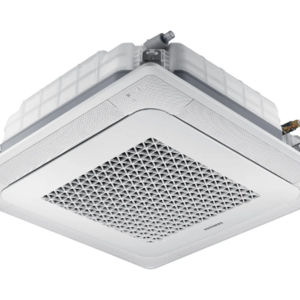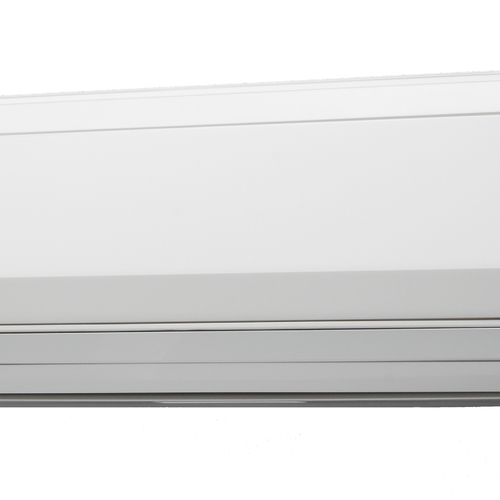
At the start of the cooling season, we sometimes get calls that water is leaking from a ductless heat pump head inside the customer’s house and running down the wall. The calls usually come with the onset of hot, humid weather, when our installation and service teams are already stretched thin. Some ductless water leaks can be traced to errors in installation, some to lack of regular maintenance, and some to user behavior. Caught early, ductless water leaks can be prevented and easily fixed. But left unaddressed, they can lead to bigger, more expensive problems.
How it’s supposed to work
Air conditioning, whether it’s a window unit air conditioner, a ductless head, or a central system, improves summer comfort by cooling and dehumidifying indoor air. With a typical wall-mounted ductless head, warm indoor air is drawn in through an opening near the ceiling. The air passes through a filter, then over a heat-exchange coil. The coil is made of copper tubing; aluminum fins increase the surface area available for heat transfer. Heat from the air moves through the fins and coils and is absorbed by the cold refrigerant inside.
As the temperature of the air drops below its dew point, liquid water condenses on the coils and drips into a drain pan immediately below. From there, the condensate runs out a flexible drain hose supplied with the unit. In the most common configuration, the head is installed on an exterior wall, and the drain opening is on the right rear of the unit. The drain hose exits the unit and passes through the wall on a slight downward pitch. Just outside the wall, the drain hose is coupled to a pipe that descends to just above ground level. When a right-side exit isn’t possible, the drain pan…
Weekly Newsletter
Get building science and energy efficiency advice, plus special offers, in your inbox.

This article is only available to GBA Prime Members
Sign up for a free trial and get instant access to this article as well as GBA’s complete library of premium articles and construction details.
Start Free TrialAlready a member? Log in















9 Comments
Illustrating once again the flaws of these systems in real life, despite the passive house fan boys in 2,000 sq feet house that look like boxes that keep promoting the “wonders” of these ugly expensive, hard to install and maintain units on homeowners. A properly sized comparably noisy ducted unit in a comparably sized and well insulated and sealed house will cost less to install, cost less to maintain, and energy savings will be overwhelmed the first time this trashes your drywall in your living room/kitchen/master BR.
Most of my clients hire me specifically because they want a house that is comfortable and affordable without being oversized. Boxiness often comes from trying to get the price for high quality down to reasonable levels. I suppose if your idea of "quality" is seeing how many different roof lines you can get over your plastic siding and disposable windows, boxiness might not appeal to you.
You must not have built anything in recent years to think that a ducted system can compete financially with mini-split heat pumps. Unless your home's envelope is so poor that you need a unit in every room, that is. In 2000 sf boxy houses with decent envelopes, just one or two mini-splits are usually enough to heat the major spaces here in climate zone 6, with a bit of electric baseboard backup in bathrooms and bedrooms. Total cost: roughly $10K or less. The last time I did a central, ducted unit in that ballpark, it was a low-end, atmospherically vented gas-fired unit with unsealed, uninsulated ducting, and it was 2007. More recently I've seen quotes for $30K for higher-end systems. That would buy a lot of mini-splits.
I find efficiency to be elegant and even beautiful. Some of my clients don't want the wall-mounted units, but the vast majority see no aesthetic issues with them. If you don't like how they look, you can choose floor-mount, ceiling-mount or slim-duct systems. Or, like most owners of wall units, you will find that they quickly fade into the background and aren't the protuberances you thought they'd be.
I don't discount the author's experience with leaking condensate drains, but it's not something I've ever seen on a job in almost ten years of designing homes with heat pumps. I don't think they are the best heating system available, and they do have their downsides, as the author and the related articles note. Their tendency to leak refrigerant is the most worrisome to me. But they fill a need that nothing else can touch, as far as I've been able to tell.
Doug,
Do you spend much time here? I don't see any passive house fan boys on GBA, just people who want a better performing house than is usually built.
We installed two ductless mini-splits in our firehall two years ago. They paid for themselves in about 14 months. They are now probably the most common heating system being installed in residential construction near me. I guess we are all just dumb.
Mini splits are great, but in my humble opinion the vinyl tube drainage is just stupid.
There is way too much risk of damage, and the hassle is inevitable. Who wants the looming threat of a condensate leak? Who wants to clean slime from a vinyl tube every year? Who is actually going to do that? Ridiculous!
Rigid PVC pipe is so much better, and for such a modest premium, I think it’s the only way the job should be done.
In our house the walls are open so I ran a 2” schedule 40 pipe all the way from the attic to a drain in the basement.
The pipe cost a fraction of what the secondary drain pan sensor did.
My hope is that the drain will never, ever clog!
ROTFL , wow. "hard to install " ??? The outside unit sits on a pad and can be wide open vs crammed into some godforsaken undersized closet or in the garage where a car is supposed to be? Hanging the inside unit is real hard though, but not if you have ever had to hang a portrait more substantial than a high school print you can pin up with your thumb tacks. Connecting the lines? Yeah, way harder (but way safer), than installing hard gas lines through foundations, walls and into the godforsaken closet described above to feed a combustion machine (furnace) with all its inherent safety. Can you say gas leak? What's that smell? Can you say explosion? Can you say carbon monoxide poisoning? Can you say CO detectors? Anyway, line attachment Hint: Righty tighty. PS. You haven't even started the AC install. Go back to square one. Repeat. Party on, dude.
On a new build, is it typical to run even a single line on the exterior of the siding like in the photo? Or can the condensate lines usually be completely hidden? I know I wouldn't be happy if I saw that kind of installation on a brand new $500k house.
I also shake my head every time I see maintenance procedures (including every HRV/ERV manual) that tell the homeowner to clean filters, lines, etc., every 3 months. Sorry, but that just isn't going to happen. Even for the handiest handyman, people have better things to do. Not necessarily right, but it ain't going to happen. The manufacturers and installers need to assume "Mary Jane" isn't EVER going to think about preventively cleaning her condensate drains.
Why the sexist comment?
Because I felt like it.
The drain pan tablets or strips are interesting. But I'm only interested if they are natural biocides and not chemical. Unfortunately Nu-Calgon's SDS says the ingredients are a trade secret and list none.
I've been looking at SDS's for everything going into my house and that's the first time I've ever seen such a statement.
Log in or become a member to post a comment.
Sign up Log in